Top News
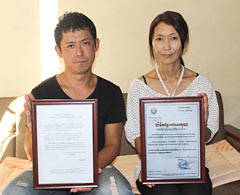
September 18, 2013 Ryukyu Shimpo
Despite struggling with a rare inherited muscle disorder known as hypokalemic periodic paralysis, Nago resident Tsubasa Ishikawa does volunteer work sending clothing to children in Cambodia. Ishikawa received a certificate of appreciation from a Cambodian nongovernmental organization.
Starting his volunteer work this spring, by August Ishikawa had sent more than 800 kilograms of clothing to Cambodia. He plans to continue his grassroots level international contribution, saying, “I am grateful to the individuals, corporations and organizations that have supported me along the way.”
Ishikawa began sending clothing to Cambodia after hearing that one of his friends had done similar volunteer work.
Although the disease he suffers from can abruptly paralyze the arms and legs, Ishikawa has not had any turns while carrying out his activities.
As well as calling for support from his friends, Ishikawa promoted the project through newspaper advertisements and personal communication. Besides individuals, Okinawa associations outside the prefecture and the country, corporations and organizations in Okinawa have provided clothing for Ishikawa’s project. Ishikawa paid the freight cost himself.
Ishikawa received a certificate of appreciation on August 27 from the Khmer Love Khmer Federation, the nongovernmental organization in Cambodia that accepted the clothing. The organization works on agricultural and study support projects in deprived areas of the country.
Ishikawa started his project after finding out that Cambodian children in poverty have no clothes to wear. He said, “I want to continue doing what I can to help these children.”
(English translation by T&CT, Mark Ealey)
Go to Japanese
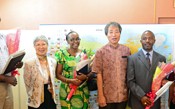
September 16, 2013 Ryukyu Shimpo
JICA Okinawa has hosted its 10,000th trainee from overseas. About 80 people, including JICA officials and trainees, celebrated this accomplishment at a ceremony held at the Okinawa International Center at Maeda, Urasoe. Toshihiro Obata, director general of JICA Okinawa, said, “It means that we have sent 10,000 fans of Okinawa to countries all over the world. We will extend this network even further and want to make effective use of it. ”
In the evening of September 14, three trainees from Kenya and Tanzania arrived in Okinawa to become the 10,000th trainees. They will take a course in public health planning on a scientific basis.
Janneth Maridadi Mghamaba, who works in the Department of Health and Human Services of Tanzania, said with a smile, “I have been looking forward to visiting Okinawa very much, because a former trainee who came back from Okinawa told me that Okinawa was a really good place.”
(English translation by T&CT, Mark Ealey)
Go to Japanese
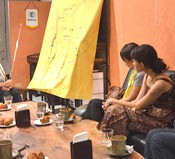
September 10, 2013 Ryukyu Shimpo
At a meeting entitled “Norihide Cafe” held in Adaniya, Kitanakagusuku, Toshie Asato, a 93-year-old survivor of the Battle of Okinawa called for there to be no more war. She lost her four-year-old son Norihide during the war. The women’s peace study group Akebi no kai published a story titled “Norihide” depicting the tragedy that unfolded for the mother and son.
After she read her book and talked about her experiences during the war, the participants discussed peace and war with her.
She lost family members as they walked around desperately in the southern and central part of Okinawa trying to escape from the battle. Looking back at that time, she said, “When I see the moves made by the government, I feel afraid that war will come again. We must never allow that to happen again!”
(English translation by T&CT, Hitomi Shinzato and Mark Ealey)
Go to Japanese
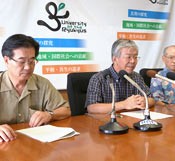
September 13, 2013 Ryukyu Shimpo
On September 12, the presidents of nine universities in Okinawa issued a statement in response to the U.S. military’s helicopter (HH-60) crash. The statement called for the U.S. military to stop flight training over and around the property of the universities.
On the same day, President of University of the Ryukyus Hajime Oshiro, President of Okinawa Christian University and Junior College Toshiaki Nakahara and Vice President of Meio University Katsumi Yamazato held a press conference at the University of the Ryukyus in Nishihara. They denounced the flight of U.S. military planes over the universities as being unforgivable from global standards of civilization. It is the second time that the nine universities’ presidents have issued a joint statement since the U.S. marine helicopter crash onto Okinawa International University in 2004. They will send the statement to the Japanese and U.S. governments and various related organizations.
Eight presidents of University of the Ryukyus, Meio University, Okinawa Prefectural College of Nursing, Okinawa Prefectural University of Arts, Okinawa International University, Okinawa University, Okinawa Christian University and Junior College, Okinawa Women’s Junior College put their names to the statement in which they asked the U.S. military to stop flight training. The statement said, “We feel it is most regrettable that the noise of U.S. aircraft flying over our campuses disrupts lectures for our students, our research, and campus life in general.”
President of Okinawa Christian University and Junior College, Nakahara, said, “By rights, universities are there to provide education and study in a quiet environment. U.S. military aircraft flying overhead prevents this.” Meio University Vice President, Yamazato, complained, “The airspace above Okinawa’s universities has become a crossroads for military aircraft. By normal international standards, this is unacceptable.”
(English translation by T&CT, Lima Tokumori and Mark Ealey)
Go to Japanese
September 13, 2013 Ryukyu Shimpo
Within the next fiscal year, the Okinawa Institute of Science and Technology (OIST) plans to set up a venture capital company that provides protein substance information to pharmaceutical companies. This information is important for companies when creating medicines. The school has a patent on the technology the new company will use.
This is the first step for the school to promote the self-sustaining development of Okinawa and to make a contribution to science and technology development in the world. They hope to promote the creation of intelligent industrial clusters and employment.
Setting up venture capital companies is part of the Program for Creating Start-ups from Advanced Research and Technology that the Ministry of Education, Culture, Sports, Science and Technology adopted in fiscal 2012. To assist with the costs of research and development and market research, the ministry provided subsidies to the program of about 1.5 million yen in fiscal 2012 and about 30 million yen in 2013.
Someone outside the school with experience running companies will become the president of the new company.
The school is now considering the location and the annual revenue target for the company, which will return part of its profit to the school as a patent royalty. OIST will put that funds towards its management costs. Ulf Skoglund, professor at the school developed the Three-Dimensional Molecular Structure Analysis. The school has a patent on this technology and the company will use it.
According to a representative of the Project Development Section of the school, pharmaceutical companies need to know how medicines that have been developed influence protein substance. The companies need to conduct many experiments to establish how medicines work because at the molecular level existing methods cannot picture about 80 percent of protein substance.
The technology that the school has developed can picture that 80 percent.
The representative said, “This technology provides effective information to pharmaceutical companies for when they have their newly-developed medicines internationally approved. It is possible that the companies will not need to conduct the experiments that currently run, which will reduce their costs.”
(English translation by T&CT, Mark Ealey)
Go to Japanese
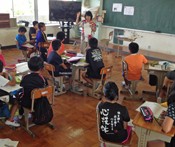
September 16, 2013 Yusho Namihira, Correspondent of the Ryukyu Shimpo
All the students in Aguni Elementary and Junior High School took part in a product development class on September 6. The class was a part of a career education support project run on Aguni.
In the class, for several hours, junior high school students studied about planning, business negotiation with manufacturers, production expenses and retail price.
The students will sell products in shops in a work experience class held on the main island of Okinawa. Elementary school students played the role of publicists, studying how to make newspapers to advertise the products that their seniors have developed. For their part, the junior high school students learned about the basics of product development.
They carried out group discussions on customer preferences regarding ice cream containing salt produced in Aguni. The participants formed an opinion about business negotiation in preparation for talks with manufacturers to be held in the next class.
The elementary school pupils studied making a newspaper featuring interviews with their seniors. They listened closely to the advice from their teachers and took notes.
(English translation by T&CT, Mark Ealey)
Go to Japanese
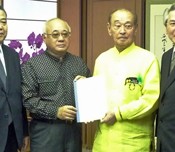
September 15, 2013 Ryukyu Shimpo
The Okinawa Prefectural Government aims to promote the use of Shimoji Airport, an airport for civil aviation training, in Miyako. Poor use of the airport has been a long-standing problem. From September 18, the Prefectural Government, which manages the airport, has started trying to attract airline companies and research institutions from both inside and outside of Okinawa. Six officials tasked with this project have been divided into three groups. They will approach the airlines companies that use Naha Airport, and those in Tokyo, Nagoya and Miyazaki, to request that they conduct training and test flights at the airport.
The Prefectural Government thinks that it will be feasible to take on training aircraft of airline companies, conduct test flights for research institutions and airline companies and provide a landing field for aircraft that mount rockets designed to launch scientific satellites. Other plans are to provide space for commercial spaceports, in which space trip participants carry out training and provide a landing field for private jet aircraft owned by wealthy people.
The government fears that the airport may be shutdown if they cannot find more users, and wants to attract business operators interested in using the airport as soon as possible.
Shimoji Island is connected to Irabu Island with a bridge. Irabu bridge that is open to traffic in 2015, will connect Irabu Island to Miyako Island. With this in the background, the prefectural government is hastening to promote the airport.
Kenichiro Tome, the head of the Civil Engineering and Construction Division of the Prefectural Government, said, “It is important for companies to know whether the airport is on land connected to Miyako Island. The information helps them decide whether or not to use the airport. Even though the Irabu Bridge is not due to be open to traffic in the first half of the next fiscal year, which makes it difficult for the government to promote the airport now, but when it does happen, the bridge opens various possibilities for the airport.”
(English translation by T&CT, Mark Ealey)
Go to Japanese
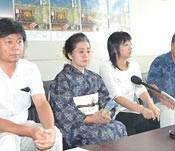
September 13, 2013 Ryukyu Shimpo
Documentary film “Ryukyu through the eyes of Chinese envoy Xu Bao Guang” has been selected as one of seven special excellent works in the Eibunren Award 2013. Eibunren is organization of short film producers in Japan. The film depicts the food culture and performing arts during the Ryukyu Dynasty, following the life of Chinese envoy Xu Bao Guang’s. He was in Okinawa during the 18th century as a sapposhi or envoy from the Emperor of China. The award ceremony will take place in Tokyo in December.
The camera crew and other staff filmed amid heightened tensions in China, where anti-Japanese demonstrations occurred after the Japanese government nationalized the Senkaku Islands in September 2012. “We were anxious when filming in China, but that timing of what was happening in the background drove us to continue filming. We were able to complete the project thanks to help from the private sector,” said director Yoshiaki Hongo when interviewed in Okinawa.
The crew interacted with some local junior high school girls who were visiting a movie village in Zhejiang. When they told them that the crew was from Okinawa, some of the girls cried and apologized for the actions of adults who had thrown stones in anti-Japanese demonstations. The director said, “Many Chinese people want to maintain good relations with Japan. So, I think that this is a meaningful project.”
Producer of Cinema Okinawa Shinya Sueyoshi explained that many different varieties of traditional arts and cuisine today evolved from those used in feasts held to host Xu Bao Guang, who stayed for about eight months. “Art and culture are born only in peaceful times. Through the movie, we want more people to know about our ancestors who were both courageous and wise to have contact with foreign countries,” he said.
The movie will be screened from October 5 to 25 at Sakurazaka Theater in Naha, and the organizer is hoping to screen the movie in China. For further information, please contact the film Production Committee Telephone: 098 (851) 7394.
(English translation by T&CT, Mark Ealey)
Go to Japanese
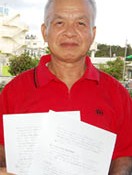
September 12, 2013 Yoshiya Hokama of the Ryukyu Shimpo
Professor Emeritus of the University of the Ryukyus Shinsho Miyara, who does research and works to help spread Uchinaguchi (Okinawan dialect), has been working to create a book provisionally titled Uchinaguchi Grammar and Idiom Guidebook. He has already written 600 A-4 size pages and will publish the book next year after adding another 100 pages. Miyara said, “There is no book that compiles the necessary grammar and idioms for studying Uchinaguchi. We need to create a guidebook like this to help spread the language.”
The guidebook compiles idioms used in Naha and Shuri. Unlike standard dictionaries, this guidebook explains idioms for learners to understand easily by putting words into grammatical categories such as nouns, verbs, and adjectives with example sentences. The book also explains how Uchinaguchi works and introduces examples of conversational expressions to make it a practical grammar book for teachers and learners.
Miyara serves as the president of the Naha City Culture Association Uchinaguchi Division and as an adviser for NPO Okinawa Language Diffusion Council. He started making the guidebook five or six years ago. Because there is no fully-fledged guidebook covering the necessary information for the teaching and learning of Uchinaguchi Miyara decided to make one by himself.
He visited schools in Hawaii to look at Hawaiian language education, which has been revitalized in recent years. Miyara found that Hawaiian translations of English textbook were used as educational material in the higher grades while there were more simple educational materials for lower grades of elementary school. He said, “In Hawaii they also need to make a grammar book. I felt that I should do my bit to make a guidebook like this. I hope that it will be something that people use widely.”
(English translation by T&CT, Megumi Chibana and Mark Ealey)
Go to Japanese
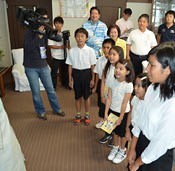
September 10, 2013 Ryukyu Shimpo
The Naha City Government has created booklets designed to help spread the use of Shimakutuba, the endangered Okinawan language. The government held a ceremony on September 9 to present the booklets to local pupils at the City Office.
The 34,000 booklets were made at the end of August.
Mayor of Naha, Takeshi Onaga, whose idea it was to create the booklets, handed them over to six representatives of the pupils. They thanked Onaga by saying “Nife debill,” which in English means “We are grateful.”

Booklets that the Naha City Government created to pass on and help spread the endangered Okinawan language of <em>Shimakutuba</em>.
Professor at University of the Ryukyus Shigehisa Karimata, who supervised the project, said, “The booklets will be of interest to many people in Japan. The way the city worked on this will serve as a model for those trying to spread Shimakutuba in Japan.”
The creators printed the booklets on A5 size paper with 70 pages. They are in full color and have many illustrations. There were 15,000 printed for lower grades of elementary school and 19,000 for the higher grades. Handbooks for teachers and digital material is also available.
The city intends to distribute the booklets to children in all the elementary schools and junior high schools in Naha. They hope that the children will use the booklets both at school and at home.
Twelve-year-old Honoka Kakazu of Kainan Elementary School said, “I want to try hard to study Shimakutuba so I can understand what my grandparents are saying and to do my best to pass on the Okinawan language to people in future.” One of the participants in the ceremony said, “Natoon,” which in English means “You can do it.”
(English translation by T&CT, Mark Ealey)
Go to Japanese
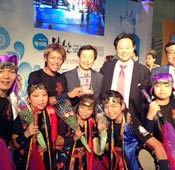
September 10, 2013 Ryukyu Shimpo
Naha based drum group Ryukaji won the top award in the 16th Busan International Travel Fair 2013 held on September 8 in the South Korean city. The leader of the group, Itsumu Tobaru, 22, who attended the ceremony the next day, was delighted, saying, “We didn’t think we would win anything.”
Many exhibitors from 43 countries and regions around the world took part in the fair. The award was the highest honor given for a performance on the main stage, on which many groups performed their own countries’ traditional arts.
The members of Ryukaji, including leader Tobaru, Kiara Kinjo, 9, Jueri Kinjo, 11, Aya Nema, 10, Asano Ikehara, 13, and Yuki Uehara, 22, displayed their stirring drum skills and a creative eisa dance on the main stage and at two locations in front of the booths. Their performance then attracted a large audience to the Okinawa booth. Tobaru said, “I was confident that we could get the audience going. I am glad that the judges noticed this.”
(English translation by T&CT, Mark Ealey)
Go to Japanese











 Webcam(Kokusai Street)
Webcam(Kokusai Street)


